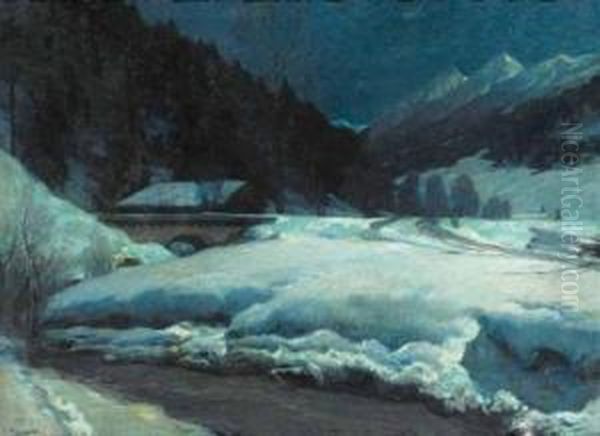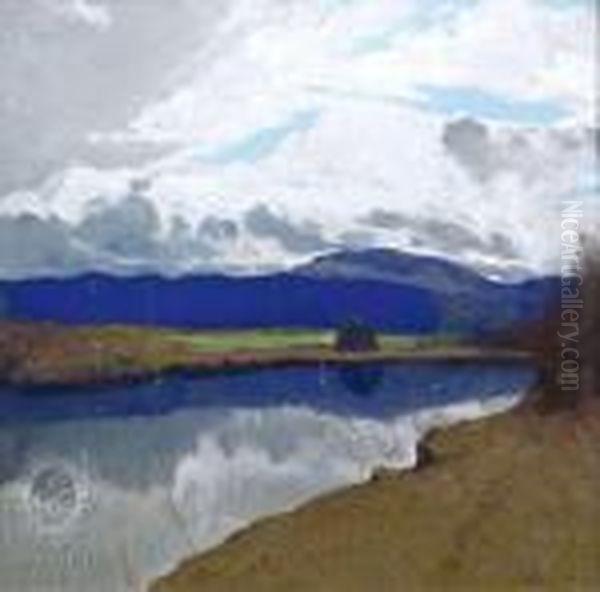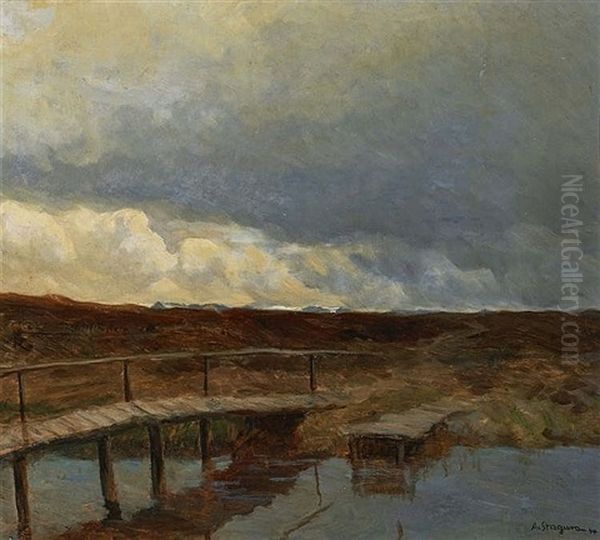Albert Stagura (1866-1947) was a German painter whose life and career spanned a period of profound artistic transformation in Europe. Born in Rawitsch, in the Prussian province of Posen (now Rawicz, Poland), and passing away in Berlin, Stagura's artistic journey saw him engage with the burgeoning Impressionist movement and participate actively in the pivotal Secession movements that sought to challenge the established academic art traditions in Germany. While perhaps not as internationally renowned as some of his direct contemporaries, Stagura carved out a respected place for himself, particularly through his evocative landscapes, insightful portraits, and engaging genre scenes.
His work reflects the broader trends of German art at the turn of the 20th century, absorbing the influences of French Impressionism yet often retaining a distinct German sensibility, characterized by a certain gravitas or introspective quality. Stagura's legacy is that of a dedicated artist who contributed to the rich tapestry of German painting during a dynamic era of change and artistic innovation.
Early Life and Artistic Formation
Albert Stagura was born on February 9, 1866, in Rawitsch, a town then part of the Kingdom of Prussia. This region, Posen, had a complex history, with a significant Polish population, and its cultural environment would have been a blend of German and Polish influences. Little is widely documented about Stagura's very early life, but his artistic inclinations led him to pursue formal training, a common path for aspiring artists of his time.
He enrolled at the prestigious Berlin Academy of Arts (Akademie der Künste, Berlin), one of Germany's foremost art institutions. At the Academy, he would have received a rigorous academic training, grounded in the classical traditions of drawing, composition, and historical painting. However, the late 19th century was a period when these academic norms were increasingly being questioned by younger generations of artists exposed to new ideas, particularly from Paris.

During his studies, Stagura was a pupil of Eugen Bracht (1842-1921), a significant German landscape painter. Bracht himself underwent an artistic evolution, initially known for his Orientalist scenes and later, under the influence of Impressionism, for his atmospheric landscapes of the German heath and countryside. Bracht's mentorship likely provided Stagura with a solid foundation in landscape painting and perhaps an early exposure to more modern approaches to light and color, even within an academic setting. This tutelage would have been instrumental in shaping Stagura's technical skills and his eye for capturing the nuances of the natural world.
The Embrace of Impressionism and Artistic Style
By the late 19th and early 20th centuries, Impressionism, which had revolutionized French art a few decades earlier, began to make significant inroads into Germany. Artists like Max Liebermann, Lovis Corinth, and Max Slevogt became leading proponents of German Impressionism. Albert Stagura was part of this wave, adapting Impressionist principles to his own artistic vision.
Stagura's style is often characterized as Impressionistic, with a clear focus on capturing the fleeting effects of light and atmosphere. His brushwork became looser, and his palette brightened compared to the darker tones typical of academic painting. He was particularly drawn to landscapes, a genre where Impressionist techniques found fertile ground. His depictions of the German countryside, coastal scenes, and garden views often convey a sense of immediacy and a keen observation of natural phenomena.
Beyond pure Impressionism, elements of Post-Impressionism can also be discerned in some of Stagura's works, perhaps in a more structured approach to composition or a heightened emotional use of color, though he generally remained closer to the Impressionist ethos than venturing into the more radical paths of Expressionism that were also emerging in Germany at the time with groups like Die Brücke (The Bridge), founded in 1905 by artists such as Ernst Ludwig Kirchner and Karl Schmidt-Rottluff.
His portraiture, another significant aspect of his oeuvre, combined Impressionistic vivacity with a sensitive rendering of the sitter's character. Genre scenes, depicting everyday life, also featured in his work, allowing him to explore human interactions and social settings through his evolving artistic language.
Key Themes and Representative Works
Landscapes formed a cornerstone of Albert Stagura's artistic output. He painted various German locales, capturing the specific character of different regions. Whether it was the rolling hills, tranquil lakes, or blossoming orchards, Stagura sought to convey the mood and atmosphere of the scene through his handling of light and color. One notable example often cited is "Am Gardasee" (At Lake Garda), suggesting he also traveled and painted scenes beyond Germany, with Lake Garda in Italy being a popular subject for many Northern European artists seeking picturesque light and scenery.

Another work, "Blühender Kirschbaum" (Blooming Cherry Tree), exemplifies the Impressionist fascination with transient beauty and the changing seasons. Such a subject allowed for a vibrant play of colors and a depiction of light filtering through blossoms, characteristic of the Impressionist approach. His winter landscapes, such as "Winterlandschaft," would have offered different challenges and opportunities to explore a more subdued palette and the stark beauty of the season.
In his portraits, such as "Porträt einer Dame" (Portrait of a Lady), Stagura aimed to capture not just a physical likeness but also the personality and inner life of his subjects. The application of Impressionist techniques in portraiture meant a departure from highly finished, formal representations, instead favoring a more lively and immediate portrayal.
His genre scenes, though perhaps less documented than his landscapes, would have provided glimpses into the daily life of his time, rendered with the same sensitivity to light and atmosphere that characterized his other works. The overall body of his work demonstrates a consistent dedication to observing and interpreting the world around him through an Impressionist lens.
Participation in Secession Movements
The late 19th and early 20th centuries in Germany were marked by the rise of Secession movements. These were associations of artists who "seceded" from the official, state-sponsored academic art institutions and their conservative exhibition policies. The Secessions aimed to promote more modern and avant-garde art, free from the juries of the established salons.
Albert Stagura was actively involved in these progressive movements. He became a member of the Berlin Secession, which was founded in 1898. The Berlin Secession was arguably the most important of these groups in Germany, with leading figures like Max Liebermann serving as its first president, and other prominent members including Walter Leistikow, Lovis Corinth, Käthe Kollwitz, and Max Slevogt. Even international artists like Edvard Munch exhibited with the Berlin Secession, highlighting its significance. Stagura's membership underscores his alignment with the modern art trends of his time and his desire to exhibit alongside like-minded, forward-thinking artists.

Later, internal tensions and disagreements within the Berlin Secession led to a split. In 1913/1914, a group of artists, including Stagura, formed the Freie Secession (Free Secession). Max Liebermann also eventually joined this new group. The Freie Secession continued the spirit of artistic independence, though it faced increasing challenges with the outbreak of World War I and the subsequent economic and political turmoil. Stagura's participation in both the Berlin Secession and the Freie Secession demonstrates his commitment to artistic freedom and his active role in the organizational aspects of the contemporary art world. These affiliations provided him with crucial platforms to exhibit his work and engage with the leading artistic currents.
The Artistic Milieu: Germany at the Turn of the Century
To fully appreciate Albert Stagura's career, it's important to understand the broader artistic context of Germany during his lifetime. The German Empire, unified in 1871, was a period of industrial growth and increasing national confidence, but also of cultural debate. The official art, favored by Emperor Wilhelm II, was often grandiose, historical, and nationalistic, exemplified by artists like Anton von Werner.
Against this backdrop, Impressionism offered a new way of seeing and representing the world. While French Impressionists like Claude Monet, Pierre-Auguste Renoir, and Camille Pissarro had already established the movement, its adoption in Germany was somewhat later and often took on distinct characteristics. German Impressionism, as practiced by Liebermann, Corinth, Slevogt, and Stagura, could be more robust in its brushwork and sometimes more somber in its palette or mood compared to its French counterpart. There was often a strong emphasis on capturing the German landscape and character.
The Secession movements in Berlin, Munich (founded 1892, with figures like Franz von Stuck), and Vienna (founded 1897, with Gustav Klimt) were crucial for breaking the stranglehold of academic art. They created spaces for diverse styles, from Impressionism and Art Nouveau (Jugendstil in Germany) to early forms of Expressionism.
Stagura's career also overlapped with the rise of German Expressionism. While his own style remained largely rooted in Impressionism, he would have been aware of the more radical artistic experiments of groups like Die Brücke in Dresden and Der Blaue Reiter (The Blue Rider) in Munich, founded by artists such as Wassily Kandinsky and Franz Marc. This vibrant, sometimes contentious, artistic environment provided a rich, if complex, setting for Stagura's development. He navigated these currents by aligning himself with the progressive yet relatively established modernism of the Secessions.
Other notable German artists of the broader period whose work formed part of the artistic landscape Stagura inhabited include the Realist Adolph Menzel, whose long career bridged earlier traditions with a keen observational eye, and the Symbolist Arnold Böcklin, whose mythological scenes were highly influential. The printmaker and sculptor Käthe Kollwitz, a fellow Secession member, offered powerful social commentary through her art.
Later Years and Legacy
Albert Stagura continued to paint and exhibit throughout the first half of the 20th century. This period encompassed World War I, the turbulent Weimar Republic, and the rise of the Nazi regime, which had a devastating impact on modern art in Germany, labeling much of it as "degenerate art" (Entartete Kunst). Artists associated with Impressionism and the Secessions, while not always as aggressively persecuted as Expressionists or abstract artists, still faced a challenging cultural climate if their work did not align with the regime's narrow aesthetic ideals.
Stagura passed away in Berlin on November 27, 1947, two years after the end of World War II. His death occurred in a city and a country grappling with immense destruction and the difficult process of rebuilding and reckoning with its recent past.
Today, Albert Stagura is recognized as a competent and dedicated German Impressionist painter. While he may not have achieved the same level of fame as the "triumvirate" of German Impressionism (Liebermann, Corinth, Slevogt), his work contributes to our understanding of the breadth and diversity of this movement in Germany. His paintings are valued for their lyrical beauty, their skillful capture of light and atmosphere, and their honest depiction of the German landscape and its people.
His involvement in the Berlin Secession and the Freie Secession also marks him as an artist who actively participated in the struggle for artistic modernism and independence from academic constraints. His works can be found in various German collections, and they occasionally appear at auctions, allowing contemporary audiences to appreciate his contribution to German art.
Conclusion
Albert Stagura's artistic journey from the academic halls of the Berlin Academy to the progressive circles of the Secession movements reflects a commitment to evolving artistic expression. As a German Impressionist, he skillfully adapted the revolutionary techniques of light and color to depict the landscapes, portraits, and genre scenes of his homeland. His paintings, such as "Am Gardasee" and "Blühender Kirschbaum," stand as testaments to his ability to capture the ephemeral beauty of the natural world and the character of his subjects.
Working alongside and in the context of major figures like Max Liebermann, Eugen Bracht, Walter Leistikow, and Lovis Corinth, and aware of the broader European artistic shifts involving artists from Edvard Munch to the emerging German Expressionists like Ernst Ludwig Kirchner, Stagura played his part in the dynamic art scene of his time. His legacy is that of a fine painter who contributed to the rich tradition of German Impressionism and actively supported the cause of modern art through his participation in the vital Secession movements. His work remains a valuable part of Germany's artistic heritage from a transformative period in art history.